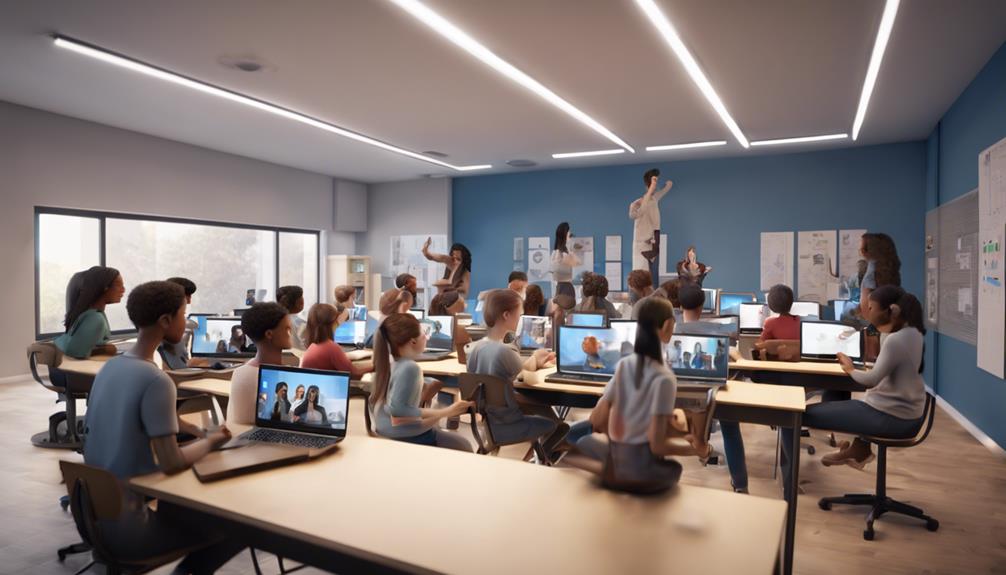Education Revolution: Remote Learning's Transformation of Education
You may not be aware that remote learning has sparked a significant shift in education, reshaping traditional classroom practices and redefining the interactions between educators and students. As you consider the implications of this transformation, you might find yourself pondering the long-term effects on educational equity and the future of personalized learning. Stay tuned to explore the impact of remote learning on traditional classroom dynamics, the challenges faced by students, and the innovative technologies shaping the future of education.
Key Takeaways
- Remote learning revolutionizes traditional education dynamics.
- Technology enhances personalized learning experiences.
- Virtual collaboration tools deepen student engagement.
- Real-time feedback and interactive content drive learning innovation.
- Policies and funding support equitable access and teacher development.
Impact on Traditional Classroom Dynamics
The shift to remote learning has profoundly altered the traditional classroom dynamics, prompting educators to reassess teaching methods and student engagement strategies.
In the domain of student engagement, the virtual setting has presented both challenges and opportunities. Classroom management has shifted from physical presence to virtual monitoring, requiring teachers to adapt their approaches to maintain student focus and participation.
Data shows that while some students thrive in the online environment due to increased flexibility and personalized learning opportunities, others struggle with distractions and lack of in-person interaction.
Educators have utilized various tools and platforms to enhance student engagement, such as interactive virtual whiteboards, breakout rooms for group activities, and real-time polls for instant feedback.
Understanding these shifts in student engagement and classroom management is essential for educators to tailor their teaching strategies effectively in the remote learning landscape, ensuring that all students have the opportunity to succeed academically.
Challenges Faced by Students
Exploring the domain of remote learning, students encounter a myriad of challenges that demand adaptability and resilience in their academic pursuits. Student engagement has been a significant hurdle during this shift. The lack of face-to-face interaction with peers and teachers can lead to feelings of isolation and disconnection, impacting motivation and participation in virtual classrooms.
Additionally, maintaining mental health has become increasingly important. The move to remote learning has blurred the lines between personal space and academic responsibilities, potentially causing stress and anxiety among students.
Accessibility and resources present another set of obstacles for students in the remote learning landscape. Disparities in internet access and technological devices create inequities in educational opportunities. Students from underserved communities may struggle to participate fully in online classes due to these limitations.
Additionally, the absence of on-campus resources like libraries, labs, and extracurricular activities can hinder students' overall learning experience. Addressing these challenges is vital to make sure all students have equal access to quality education in the digital age.
Opportunities for Educational Equity
Amidst the challenges posed by remote learning, opportunities for enhancing educational equity have emerged with a focus on innovative solutions and inclusive practices. The digital divide, which has long been a barrier to equal access to education, is being addressed through initiatives that provide accessible resources to students in underserved communities. By leveraging technology, educational institutions are offering personalized learning experiences tailored to individual needs, promoting a more essential educational landscape.
Inclusive practices are also playing a vital role in ensuring that all students have the opportunity to thrive in a remote learning environment. Schools are implementing strategies to accommodate diverse learning styles and needs, fostering a more inclusive educational experience for students from different backgrounds.
The shift towards accessible resources and personalized learning not only helps bridge the digital divide but also promotes educational equity by catering to the unique requirements of each student. Through embracing inclusive practices, schools are creating a more essential educational system that empowers all students to succeed.
Innovations in Learning Technologies
Addressing the need for continuous improvement and adaptation, the advancements in learning technologies have revolutionized the educational landscape, reshaping how students engage with content and interact with educators.
Virtual simulations offer an interactive and immersive learning experience, enabling students to explore complex concepts in a practical and engaging manner. These simulations bridge the gap between theory and practice, allowing learners to experiment, make mistakes, and learn from their experiences in a risk-free environment.
Adaptive programs, on the other hand, cater to individual learning needs by personalizing the educational journey for each student. By analyzing data on student performance and behavior, these programs adjust the difficulty level and content delivery in real-time, ensuring that students receive tailored support and challenges. This personalized approach not only enhances student engagement but also promotes a deeper understanding of the material.
Incorporating virtual simulations and adaptive programs into the educational framework opens up new possibilities for interactive and personalized learning experiences, ultimately transforming the way students acquire knowledge and skills.
Teacher Training and Support
You must acknowledge the critical role of enhanced teacher preparation and ongoing professional development in the success of remote learning.
Data shows that educators who receive thorough training and continuous support are better equipped to navigate the challenges of online instruction and effectively engage students.
Investing in these areas isn't just beneficial during times of crisis but is essential for the long-term evolution of education in a digital age.
Enhanced Teacher Preparation
Effective teacher preparation programs have become increasingly essential in ensuring educators are equipped to navigate the challenges and opportunities presented by the shift to remote learning in education.
With the move to virtual classrooms, teachers now rely heavily on online resources to deliver quality education. Teacher training must adapt to this new landscape by integrating technology tools, instructional strategies for online platforms, and methods to engage students virtually.
One key aspect of enhanced teacher preparation is providing educators with training on utilizing various online resources effectively. Teachers need to be proficient in leveraging digital platforms to create interactive and engaging virtual lessons. Understanding how to curate and utilize online resources enhances the quality of education delivered in remote settings.
Additionally, teacher preparation programs should focus on fostering a supportive community where educators can collaborate and share best practices for the virtual classroom environment.
Ongoing Professional Development
Continuous professional development plays a pivotal role in equipping educators with the necessary skills and knowledge to thrive in the evolving landscape of remote learning. In the domain of education revolutionized by remote learning, ongoing professional development is the cornerstone for continuous improvement and skill enhancement among teachers.
Lifelong learning and career growth are no longer just buzzwords but essential components for educators to stay relevant and effective in their roles. Data shows that teachers who engage in regular professional development opportunities are better equipped to navigate the challenges of remote teaching. Studies indicate that ongoing training leads to increased student engagement, improved academic outcomes, and enhanced teacher satisfaction.
Social and Emotional Learning
The integration of social and emotional learning within remote education platforms has become an essential component in fostering holistic student development and well-being. Addressing student well-being and mental health through remote learning is vital, especially considering the challenges students face in isolation.
Studies have shown that incorporating social and emotional learning strategies can greatly improve students' mental health outcomes and overall well-being. By focusing on community building and relationships in the virtual classroom, educators can create a supportive environment where students feel connected and valued.
Building relationships in remote learning environments is essential for promoting a sense of belonging and reducing feelings of isolation. Research indicates that students who feel connected to their peers and teachers are more engaged in their learning and experience better emotional regulation.
Implementing activities that encourage interaction and collaboration among students can enhance social-emotional skills and contribute to a positive learning environment. Prioritizing social and emotional learning in remote education not only benefits students' mental health but also fosters a supportive community where students can thrive academically and emotionally.
Future of Remote Education
Amidst the evolving landscape of education, the future of remote education is poised to revolutionize traditional learning paradigms. Virtual collaboration tools are becoming increasingly sophisticated, enabling seamless interaction among students and educators regardless of physical distance. This enhanced virtual collaboration fosters deeper engagement and more personalized learning experiences, breaking down the barriers of traditional classrooms.
Remote assessment methods are also advancing rapidly, ensuring academic integrity in online learning environments. With the integration of AI-powered proctoring systems and secure online examination platforms, educators can effectively monitor and evaluate student performance without compromising the integrity of assessments.
To thrive in the future of remote education, fostering student engagement remains paramount. Incorporating interactive multimedia content, gamified learning experiences, and real-time feedback mechanisms are essential strategies to keep students motivated and actively participating in their education journey.
As the landscape of education continues to evolve, the future of remote education holds immense potential to reshape the way we learn, collaborate, and assess academic achievements.
Policy Implications and Recommendations
Considering the advancements in remote learning technologies and the evolving educational landscape, it's essential to analyze the policy implications and provide strategic recommendations for optimizing the integration of remote education into traditional learning frameworks.
Funding allocation plays a vital role in ensuring equitable access to remote learning resources for all students. Policymakers should prioritize allocating resources effectively to bridge the digital divide and support schools in implementing robust remote learning infrastructures.
To enhance teacher retention in remote education settings, policies should focus on providing professional development opportunities, mentorship programs, and competitive compensation packages.
Curriculum adaptation is another key aspect that policymakers need to address. Developing flexible and engaging online learning materials tailored to diverse student needs is essential. Integrating interactive elements, multimedia resources, and real-world applications can enhance student engagement in remote learning environments.
Additionally, promoting collaborative projects and peer-to-peer interactions can foster a sense of community and belonging among students.
Conclusion
In summary, remote learning has revolutionized education by challenging traditional norms and fostering innovative teaching strategies. As the educational landscape continues to evolve, it's vital for educators to adapt and embrace the opportunities presented by virtual learning environments.
The future of education lies in the hands of those willing to embrace change and harness the power of technology to create engaging and equitable learning experiences. The classroom of tomorrow isn't bound by walls, but by the limitless potential of digital tools.







